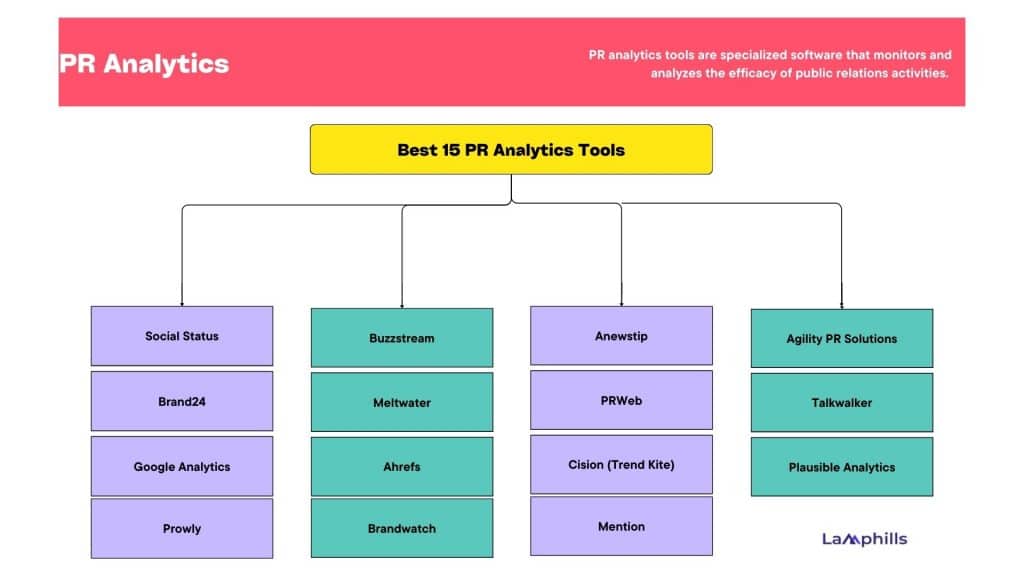Sometimes PR feels like flinging spaghetti against a wall. You create excellent press releases, pitch like a pro, and secure fantastic placements… but what next? Ugh, the age-old question: Did it all matter? Historically, quantifying PR performance has been a frustrating guessing game. But not to worry, my fellow PR soldiers! In this data-driven world, there is one bright spot: PR analytics.
Key Takeaways
- PR Analytics goes beyond counting press releases and delves into sentiment analysis, reach, brand mentions, and website traffic. This data helps you understand the impact of your campaigns and make informed decisions.
- PR analytics helps avoid the “spaghetti at the wall” approach. The author shares a personal story where great placements didn’t translate to website traffic, emphasizing the need for data-driven insights.
- These tools track media mentions, analyze sentiment, monitor social media engagement, and measure influencer impact. They empower you to optimize every aspect of your PR efforts.
- It’s not a one-size-fits-all situation. Consider your team’s needs, research different tools, assess integration with existing systems, and explore free trials and demos before committing.
What is PR Analytics?
Think of PR analytics as your personal data fortress, overflowing with insights into your campaigns’ performance. It goes beyond just counting clips (been there, done that!). We’re talking about analyzing sentiment, audience reaches, brand mentions, and website traffic – all the juicy details that tell you if your PR efforts are landing punches or whiffing entirely.
I’ve experienced the thrill of launching a PR campaign and the anxiety of waiting to see its impact. PR Analytics has been my trusted ally in deciphering the numbers and understanding the true story behind each campaign’s success or failure.
Also, in my years in the field, I’ve seen how PR Analytics can transform a mediocre campaign into a stellar success story. By delving into metrics like media mentions, sentiment analysis, and audience engagement, PR Analytics paints a vivid picture of your PR landscape, empowering you to make informed decisions and fine-tune your strategies for maximum impact.
Why PR Analytics is Important
Let me tell you a story. In my previous workplace, we launched a killer campaign for a sustainable shoe company. We got featured in major publications, influencers raved about them, and we felt like PR rockstars. But then, the analytics reports came in. Website traffic was crickets, and brand awareness barely budged. Turns out, our outreach wasn’t targeted to the right audience, and the placements, while impressive, weren’t driving the results we needed.
Again, I’ve seen firsthand how PR Analytics can turn a floundering campaign around. By analyzing key metrics like reach, engagement, and sentiment, I’ve been able to pinpoint what’s working and what’s not, allowing me to pivot my strategy and achieve remarkable outcomes for my clients.
That’s the power (and necessity) of PR analytics. It helps you understand what’s working, what’s not, and most importantly, why. With this knowledge, you can refine your strategies, maximize your ROI, and finally prove the value of your PR magic to even the most skeptical stakeholders.
Features of PR Analytics
So, what exactly can PR Analytics do for you? Let’s take a closer look at some of its standout features:
Brace yourself for a wave of excitement as I uncover the treasure trove of insights that PR Analytics has to offer. From tracking media mentions and sentiment analysis to monitoring social media engagement and influencer impact, PR Analytics gives you the tools you need to measure, analyze, and optimize every aspect of your PR campaigns.
The ability to track media mentions has been a game-changer by experience. By staying on top of the conversation surrounding my clients’ brands, I’ve been able to respond swiftly to emerging trends, address potential crises, and capitalize on opportunities for positive exposure.
Pros and Cons of PR Analytics
Now, let’s be honest, PR analytics isn’t perfect. Here are some pros and cons to consider:
Pros:
- Data-driven decision-making: Ditch the guesswork and make informed decisions based on concrete data.
- Improved ROI: Measure the impact of your PR efforts and maximize your return on investment.
- Identify trends and opportunities: Use analytics to uncover trends and adjust your strategies to capitalize on new opportunities.
Cons:
- Data overload: It’s easy to get bogged down in a sea of data. Focus on the metrics that matter most to your specific goals.
- Vanity metrics vs. actionable insights: Not all data is created equal. Learn to differentiate vanity metrics (like follower count) from actionable insights that drive results.
- Tool limitations: Some PR analytics tools may have limitations depending on your budget and needs.
In my journey with PR Analytics, I’ve experienced both the highs and lows of data analysis. While the ability to track and measure PR performance has been invaluable, I’ve also encountered challenges such as data overload and the need for specialized expertise to interpret the results effectively.
What are PR Analytics Tools?
PR analytics tools are specialized software that monitors and analyzes the efficacy of public relations activities. They offer essential indicators including media mentions, sentiment analysis, audience engagement, and reach. The goal is to help PR professionals understand how the general public and media perceive and respond to their efforts.
Download Lamphill Checklist
Download Lamphill Template
Best 15 PR Analytics Tools

Ready to take your PR game to the next level? Check out these top-tier PR analytical tools that are transforming how marketers approach public relations efforts:
#1. Social Status
- Free plan available
- From $6.75/month (billed annually)
Social Status is a strong social media analytics and reporting tool that generates automatic social media reports, influencer analytics, ad analytics, and social media benchmarks. Its distinguishing feature is its capacity to automate social media reports, making it the perfect tool for individuals seeking automated social media reports.
#2. Brand24
- 14-day free trial
- From $79/month (annually)
Brand24 is a PR analytics tool that allows organizations to track and analyze brand mentions and sentiment across various online platforms in real-time. Brand24’s advanced features, such as sentiment analysis, allow public relations professionals to analyze public perception, discover trends, and assess the emotional response to their communications.
#3. Google Analytics
- Offers a free version with comprehensive features for small to medium-sized businesses
- From $150,000 per year (billed annually)
Google Analytics enables marketing teams to assess PR efforts by tracking metrics using simple data visualizations. The solution can help organizations learn a lot about the effectiveness of their public relations strategies.
#4. Prowly
- Free 7-day trial
- $369 per month
Not every team has access to the high costs of Muck Rack, Cision, Meltwater, or Roxhill. Prowly is a PR tool that routinely outperforms review sites such as G2 while costing less. Prowly provides a media list of approximately one million contacts. Their products can be used to discover media contacts, create press releases, and track media coverage.
#5. Buzzstream
- Free trial.
- $29/mo for the Starter plan.
Buzzstream is a powerful, user-friendly digital PR tool for both link builders and digital PR pros. After using Buzzstream for nearly five years, here are the features that I’ve discovered make it best-in-class for digital PR teams:
Contact Organization and Relationship Tracking: With complete insight into who was contacted, in which campaign, and by which team members, digital PR teams can guarantee that contacts aren’t getting repeatedly emailed for coverage.
Comprehensive Reporting: Buzzstream also generates useful reports for project, agency, and company-wide data.
#6. Meltwater
- Free demo available
- Pricing upon request
Meltwater is a social media monitoring tool that many PR and marketing professionals use to track online news, analyze public opinion, and assess campaign performance. Users can also use the service to communicate with audiences on social media networks, curate content, and keep track of their competitors and trending stories.
#7. Ahrefs
- Pricing: $99/mo for Lite Version
There are numerous approaches to developing a fantastic digital PR idea; one tool rarely does it all. Ahrefs is the one that will get you the closest. Ahrefs is a powerful package for thorough SEO analysis and optimization, and it includes several features that might help with content ideation if you know where to look.
#8. Brandwatch
- Pricing upon request
Brandwatch is a comprehensive social media monitoring tool for large organizations that offers a specialized analytics panel for managing and measuring PR campaigns. If you manage a marketing team at an enterprise-sized firm, you can use Brandwatch to successfully monitor key topics and social media mentions while also sharing your voice.
#9. Anewstip
- 7-day free trial
- From $160/month.
Anewstip’s world-class database enables marketing teams to connect with relevant media outlets on a massive scale.
The platform is a pitch automation tool that allows you to reach out to media outlets at scale. Anewstip offers a builder tool for creating personalized pitch message templates, as well as an AI-powered matchmaker solution that assesses your pitch’s content and topic and recommends journalists who are likely to respond and hear your story.
#10. PRWeb
- Free account available
- From $105/press release
PRWeb is a press release distribution service that assists marketing teams in creating and sharing stories with the public. The platform is a press release distribution service that provides a diverse set of media partners and distribution platforms. PRWeb, now owned by Cision, has a permanent press release section on its website, which attracts over 12 million views each year.
#11. Cision (Trend Kite)
- Starting price: Pricing undisclosed, but estimated $7,200 per year; no free trial.
TrendKite was a useful PR intelligence tool for many years, so much so that it was folded into the PR behemoth Cision in 2019. Its vestiges can now be seen on Cision’s website under the Analytics and Impact products.
#12. Mention
- Starting price: $41/month paid annually; 14-day free trial
Mention allows you to monitor what others are saying about you (or your competitors) on the internet and social media. You can use it not just to monitor your online reputation, but also to create and share content.
#13. Agility PR Solutions
- Free demo available
- From $350/month
Agility PR Solutions is a PR tool that assists marketing teams in tracking online media coverage and measuring results. The platform’s self-service monitoring tool allows businesses to stay up to date on coverage and track all key content sources.
#14. Talkwalker
- Although not released, the tool used to be advertised at $9,000/mo.
Talkwalker is a comprehensive monitoring tool for digital PR professionals, offering social media analytics and media monitoring. It gives real-time information about brand mentions, social trends, sentiment analysis, and competitive intelligence.
#15. Plausible Analytics
Starting price: $5/month; 30-day free trial
Plausible is also a favored forerunner in the battle for moral PR analytics since it has always prioritized privacy in its tools. This is one of the reasons why firms use it on their own websites. Plausible can be connected with your Prezly account.
How to Choose the Right Tools for Your Digital PR Team
Choosing the best PR analytics tool for your digital team requires trial and error. Ensure that it meets your specific needs and goals. Some of the tools on my list are modest, supporting tools, while others are full platforms. Each should be analyzed differently. Here are some ways to find the right tool that fits:
- Assess Your Team’s Requirements: What are your team’s needs and challenges? Identify areas where tools might help with efficiency, such as finding contacts, developing content assets, and analytics.
- Research: Conduct research to learn about the tools accessible on the market. Compare the features, functionality, user interface, customer service, and price.
- Consider Integration: When testing the tool, ensure that it works with your existing systems and processes.
- Assess Your Budget: Compare the cost of the tool to the value it gives. Consider not only the upfront cost but also the possible long-term advantages and ROI.
- Demo Everything: Most tools offer free trials or demonstrations. When possible, make use of these. Hands-on experience will be the most effective way to determine a fit.
- Read Reviews and Recommendations: Read as many reviews as you can about your options. Real-world experiences can provide useful information on a tool’s performance and reliability.
Download Lamphill Checklist
Download Lamphill Template
What is PR in Data Analytics?
PR in data analytics refers to the application of public relations (PR) principles and strategies within the realm of data analytics. It involves leveraging data-driven insights to inform and optimize PR campaigns, strategies, and tactics. Essentially, PR in data analytics combines the art of storytelling and relationship-building with the science of data analysis to enhance the effectiveness and impact of public relations efforts.
How to Do a PR Analysis
Here’s a breakdown of “how” to actually conduct a PR analysis:
- Define Your Goals and Objectives
- Gather Your Data
- Analyze and Interpret the Data
- Compare to Benchmarks
- Identify Areas for Improvement
- Reporting and Recommendations
Bonus Tip: Consider conducting a pre-campaign analysis to establish a baseline and measure progress throughout your campaign.
Remember, PR analytics is an ongoing process. By regularly analyzing your data and refining your strategies, you can ensure your PR efforts are impactful and deliver measurable results.
What is Data Analysis in PR?
Data analysis in PR refers to the process of systematically examining and interpreting data related to public relations activities and outcomes. It involves collecting, organizing, and analyzing various types of data to gain insights into the effectiveness, impact, and success of PR campaigns, strategies, and initiatives.
Why are Analytics Important in PR?
Analytics are crucial in PR for several reasons:
- Performance Measurement
- Insights and Trends
- Evidence-Based Decision Making
- ROI Measurement
- Continuous Improvement
Analytics play a vital role in modern PR practices by providing actionable insights, facilitating data-driven decision-making, and driving campaign success.
What is the Difference Between PR and SEO?
PR helps people find you, while SEO helps them find you online. Both are crucial for building a strong online presence.
Conclusion
PR analytics can be a game-changer, but remember, it’s a journey, not a destination. As you delve deeper into this data wonderland, you’ll constantly learn and refine your approach. Here’s the best part: you’re not alone!
So, what are your biggest challenges or questions when it comes to PR analytics? Share your thoughts in the comments below, and let’s keep the conversation going. Together, we can turn PR frustration into data-driven fascination (and ultimately, conversions!).
Related Articles
- The Essential Content Marketing Analytics Tools and Metrics to Monitor
- Backlink Outreach: Meaning, Types & How to Build a Successful One
- Top Entertainment PR Firms: Our 2024 Picks
- 2024 Comprehensive List of Magazines: Every Reader Guide






